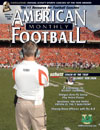AMERICAN FOOTBALL MONTHLY THE #1 RESOURCE FOR FOOTBALL COACHES
Article CategoriesAFM Magazine
|
Combating Offensive Speed with the 4-4 Defenseby: Mike Kuchar© More from this issue Whatever is being done at a higher level is usually filtered and quickly replicated through to the high school ranks. Packages like the zone read offense, the ‘spread’ rugby style punt formation and odd-stack defenses have become the norm now at lower levels. Although trends come in cycles, perhaps no scheme in football, except for the I formation offense, has had as much consistency as the 4-4 defense. Yet despite the popularity of the defense, teams have recently started to shift to utilizing more odd style fronts like the 5-2, 5-3 or the ever present 3-3-5 that West Virginia University has made so popular. A big reason why is to get more speed on the field. Playing with only three defensive linemen and five defensive backs presents positive or neutral match ups against teams that run the spread and the zone read. However....The full article can only be seen by subscribers. Subscribe today!
|
|
|||||||
| HOME |
MAGAZINE |
SUBSCRIBE | ONLINE COLUMNISTS | COACHING VIDEOS |
Copyright 2025, AmericanFootballMonthly.com
All Rights Reserved





